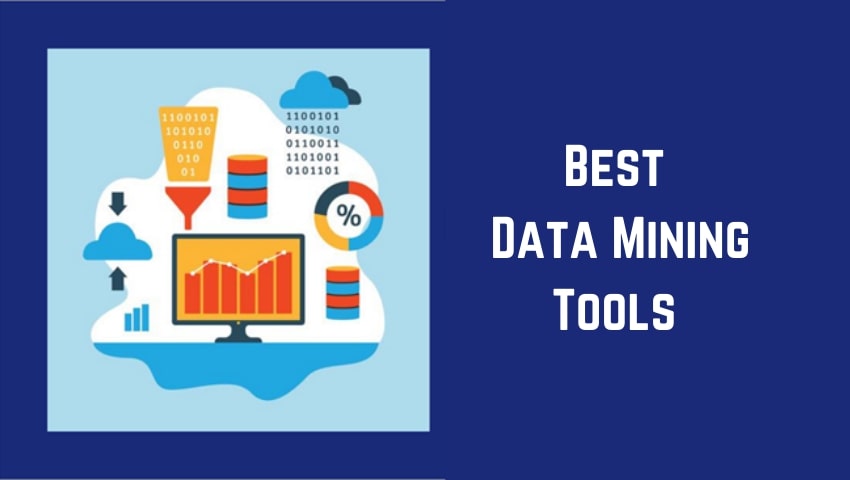Data means money in today’s world. With the transition to an app-based world, data has grown exponentially. However, since most data is unstructured, smart tools are needed to extract useful information from the data and transform it into an understandable and usable form.
Data mining or “knowledge discovery in databases” is the process of discovering patterns in large data sets through artificial intelligence, machine learning, statistics, and database systems.
Free data mining tools include complete model development environments such as Knime and Orange, to various libraries written in Java and C++, the most common being Python. Below mentioned are the top 10 best and most used Data mining tools.
Best Data Mining Tools
1) Rapid Miner
Rapid Miner, formerly known as YALE. It is an environment for machine learning and data mining experiments for research and actual data mining tasks.
There is no doubt that this is the world’s leading open source system for data mining.
It is written in the Java programming language and provides advanced analysis through a template-based framework.
2) IBM SPSS Modeler
The IBM SPSS Modeler tool workbench is most suitable for large projects such as text analysis, and its visual interface is very valuable.
It allows you to generate various data mining algorithms without programming. It can also be used for anomaly detection, Bayesian networks, CARMA, Cox regression, and basic neural networks that use multilayer perceptrons for back propagation learning.
3) Oracle Data Mining
As part of the “advanced analytical database” option, Oracle data mining capabilities allow its users to discover insights, make predictions, and leverage their Oracle data. You can build models to discover customer behaviour to target customers and develop profiles.
The Oracle Data Miner GUI enables data analysts, business analysts, and data scientists to process data in the database using a fairly elegant drag-and-drop solution.
It can also create SQL and PL/SQL scripts for the automation, scheduling and deployment of the entire enterprise.
4) Teradata
Teradata recognizes that although big data is awesome, if you don’t actually know how to analyze and use it, then it is worthless.
It provides end-to-end solutions and services in data warehousing, big data and analysis, and marketing applications.
It also provides a range of services, including implementation, business consulting, training and support.
5) Kaggle
Kaggle is the world’s largest data science community. Companies and researchers post their data, and statisticians and data miners from all over the world compete to make the best model.
Kaggle is a platform for data science competitions. It helps you solve difficult problems, recruit strong teams, and expand your data science talent.
6) Rattle
Rattle provides a statistical and visual summary of data, converts data into forms that can be easily modelled, builds unsupervised and supervised models from the data, presents the performance of the model graphically, and scores new data sets.
It is a free and open source data mining toolkit written in statistical language R using Gnome graphical interface. It runs under GNU/Linux, Macintosh OS X and MS/Windows.
7) KNIME
Konstanz information collector is a user-friendly, understandable, and comprehensive open source data integration, processing, analysis and exploration platform. It has a graphical user interface to help users easily connect nodes for data processing.
KNIME also integrates various components of machine learning and data mining through a modular data pipeline concept, and has attracted the attention of business intelligence and financial data analysis .
8) Python
As a free and open source language, Python is usually compared with R for ease of use. Unlike R, Python has a very short learning curve, which makes it a legend.
Many users find that they can start building data sets and complete extremely complex affinity analyses in minutes.
As long as you are familiar with basic programming concepts such as variables, data types, functions, conditions, and loops, the most common business use case data visualization is easy.
9) Orange
Orange is a component-based data mining and machine learning software suite written in Python. It is a novice and expert in open source data visualization and analysis.
Data mining can be done through visual programming or Python scripting. It also includes data analysis, different visualizations, features ranging from scatter plots, bar graphs, trees, to tree graphs, networks, and heat maps.
10) SAS Data Mining
Use SAS Data Mining commercial software to discover data set patterns. Its descriptive and predictive modeling provides insights for better understanding of the data.
They provide an easy-to-use GUI. They have automated data processing tools, and the cluster can finally find the best results for correct decisions.
As a commercial software, it also includes advanced tools such as scalable processing, automation, enhanced algorithms, modeling, data visualization, and exploration.
